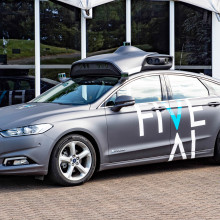It has been announced by the government that driverless cars will be trialled on the roads of the UK by January 2015. The Ministry for Transport has invited cities to compete to host one of 3 trials. But the UK aren't the first to allow testing on public roads- California, Nevada and Florida have all approved tests of the vehicles, and in 2013, Nissan carried out Japan's first public road test of an autonomous vehicle on a highway.
In this episode

00:00 - Driverless Cars
Driverless Cars
Since cars were first invented, they have slowly been becoming more and more automated- anti-lock breaking and cruise control are now common in most vehicles...
Cars which automatically maintain a safe distance from the car in front, and even which can park themselves are now available for sale. However it is likely that completely autonomous vehicles are still a way away.
Driverless cars use varying combinations of lasers, sonar, radar and infrared sensors to scan the road ahead and around them. Combined with cameras to detect road marking and signs and GPS to navigate, this allows them to build up a picture of the world they are travelling through.
Google's autonomous car, for example, uses 64 rotating laser beams called 'Lidar' taking more than a million measurements per second to form a 3D model that's accurate to the centimeter.
In the future, it is likely that cars will be able to communicate with each other. This means the car could have advance warning of vehicles ahead breaking or changing lane, making it much easier and safer for them to plan their manoeuvres. One of these systems is currently being tested in Detroit.
Better communication will also allow driverless cars to form 'road trains', following each other. This will reduce accidents and traffic jams, increasing the capacity of the roads. The aerodynamic effect will also to improve fuel efficiency by up to 30%.
The National Highway Traffic Safety Administration estimates that more than 90 percent of road crashes involve human error so it is likely that driverless cars will actually be safer than current vehicles.
One of the biggest barriers in bringing autonomous vehicle to market is price. The Lidar, on the roof of Google's cars, currently costs around $75,000. However they hope to have it down to a more affordable price by 2018.
Legal issues are also contentious, as many driving laws will need to be rewritten. If an autonomous car does crash, it isn't clear who would be responsible, so this makes insurance complicated.









Comments
Add a comment